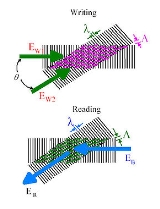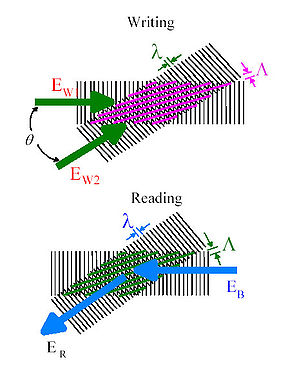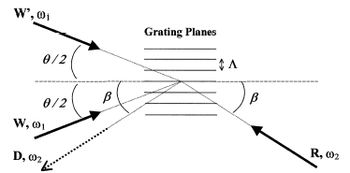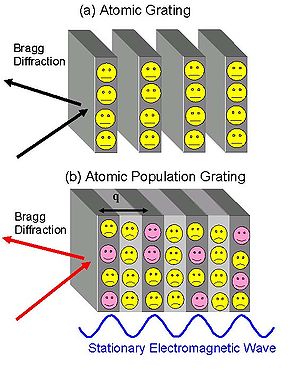
Electromagnetically induced grating
Encyclopedia
Electromagnetically induced grating (EIG) is an optical interference phenomenon where an interference pattern is used to build a dynamic spatial diffraction grating
in matter. EIGs are dynamically created by light
interference on optically resonant materials and rely on population inversion
and/or optical coherence
properties of the material. They were first demonstrated with population gratings on atoms. EIGs can be used for purposes of atomic/molecular velocimetry, to probe the material optical properties such as coherence and population life-times, and switching and routing of light. Related but different effects are thermally induced gratings and photolithography gratings.
 . The writing and reading frequencies are not necessarily the same. E_B is referred as the "backward" reading beam and ER is the signal obtained by diffraction on the grating.
. The writing and reading frequencies are not necessarily the same. E_B is referred as the "backward" reading beam and ER is the signal obtained by diffraction on the grating.
 The phase-matching conditions for the EIG for the plane-wave approximation is given by the simple geometric relation:
The phase-matching conditions for the EIG for the plane-wave approximation is given by the simple geometric relation:
 ,
,
where the angles are given according to Fig. 2, and
and  are the frequencies of the writing (W, W') and reading beam (R), respectively, and n is the effective index of refraction of the medium.
are the frequencies of the writing (W, W') and reading beam (R), respectively, and n is the effective index of refraction of the medium.

 Matter Gratings: The writing lasers form a grating by modulating density of matter or by localizing matter (trapping) on the regions of maxima (or minima) of the writing interference fields. A thermal grating is an example. Matter gratings have slow dynamics (milliseconds) compared to population and phase gratings (potentially nanoseconds and faster).
Matter Gratings: The writing lasers form a grating by modulating density of matter or by localizing matter (trapping) on the regions of maxima (or minima) of the writing interference fields. A thermal grating is an example. Matter gratings have slow dynamics (milliseconds) compared to population and phase gratings (potentially nanoseconds and faster).
Population Gratings: The writing lasers are resonant with optical transitions in the matter and the grating is formed by optical pumping
. (See Fig. 3)
Coherence Gratings: A grating where the writing lasers form a coherent matter pattern. An example is a pattern of electromagnetically induced transparency
s at an angle are used to build an EIG. The EIG is used to diffract a third laser, to monitor the behavior of the underlying substrate where the EIG was written or to serve as a switch for one of the lasers involved in the process.
Diffraction grating
In optics, a diffraction grating is an optical component with a periodic structure, which splits and diffracts light into several beams travelling in different directions. The directions of these beams depend on the spacing of the grating and the wavelength of the light so that the grating acts as...
in matter. EIGs are dynamically created by light
Light
Light or visible light is electromagnetic radiation that is visible to the human eye, and is responsible for the sense of sight. Visible light has wavelength in a range from about 380 nanometres to about 740 nm, with a frequency range of about 405 THz to 790 THz...
interference on optically resonant materials and rely on population inversion
Population inversion
In physics, specifically statistical mechanics, a population inversion occurs when a system exists in state with more members in an excited state than in lower energy states...
and/or optical coherence
Coherence (physics)
In physics, coherence is a property of waves that enables stationary interference. More generally, coherence describes all properties of the correlation between physical quantities of a wave....
properties of the material. They were first demonstrated with population gratings on atoms. EIGs can be used for purposes of atomic/molecular velocimetry, to probe the material optical properties such as coherence and population life-times, and switching and routing of light. Related but different effects are thermally induced gratings and photolithography gratings.
Writing, Reading and Phase matching conditions for EIG diffraction
Figure 1 shows a possible beam configuration to write and read an EIG. The period of the grating is controlled by the angle . The writing and reading frequencies are not necessarily the same. E_B is referred as the "backward" reading beam and ER is the signal obtained by diffraction on the grating.
. The writing and reading frequencies are not necessarily the same. E_B is referred as the "backward" reading beam and ER is the signal obtained by diffraction on the grating.
 ,
,where the angles are given according to Fig. 2,
 and
and  are the frequencies of the writing (W, W') and reading beam (R), respectively, and n is the effective index of refraction of the medium.
are the frequencies of the writing (W, W') and reading beam (R), respectively, and n is the effective index of refraction of the medium.
Types of EIG

Population Gratings: The writing lasers are resonant with optical transitions in the matter and the grating is formed by optical pumping
Optical pumping
Optical pumping is a process in which light is used to raise electrons from a lower energy level in an atom or molecule to a higher one. It is commonly used in laser construction, to pump the active laser medium so as to achieve population inversion...
. (See Fig. 3)
Coherence Gratings: A grating where the writing lasers form a coherent matter pattern. An example is a pattern of electromagnetically induced transparency
Electromagnetically induced transparency
Electromagnetically induced transparency is a coherent optical nonlinearity which renders a medium transparent over a narrow spectral range within an absorption line...
Applications
Usually two laserLaser
A laser is a device that emits light through a process of optical amplification based on the stimulated emission of photons. The term "laser" originated as an acronym for Light Amplification by Stimulated Emission of Radiation...
s at an angle are used to build an EIG. The EIG is used to diffract a third laser, to monitor the behavior of the underlying substrate where the EIG was written or to serve as a switch for one of the lasers involved in the process.

